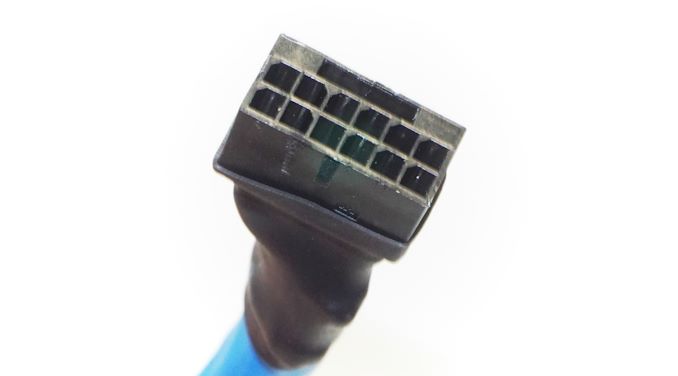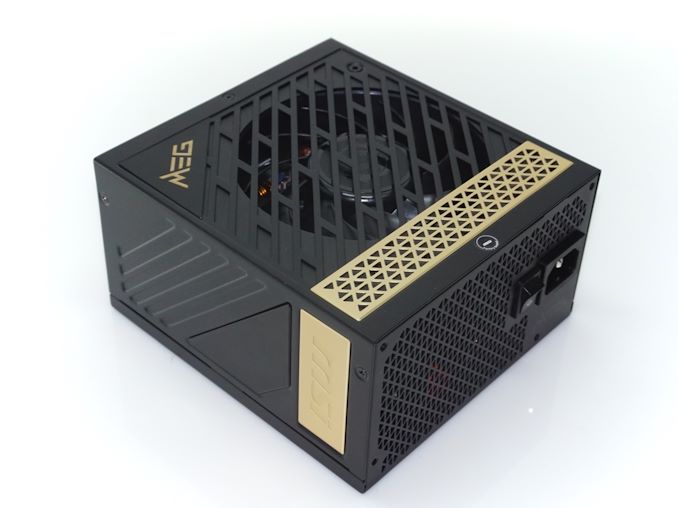The MSI MEG Ai1300P PCIE5 1300W PSU Review: The ATX 3.0 Era Has Begun
by E. Fylladitakis on December 8, 2022 11:00 AM EST- Posted in
- Cases/Cooling/PSUs
- PSUs
- MSI
- PCIe 5.0
- ATX v3.0
Power Supply Quality
As part of our testing, we also check output parameters are within specifications, as well as voltage ripple and line noise.
| Main Output | ||||||||
| Load (Watts) | 264.41 W | 659.2 W | 975.71 W | 1297.87 W | ||||
| Load (Percent) | 20.34% | 50.71% | 75.05% | 99.84% | ||||
| Amperes | Volts | Amperes | Volts | Amperes | Volts | Amperes | Volts | |
| 3.3 V | 2.32 | 3.37 | 5.79 | 3.37 | 8.68 | 3.36 | 11.58 | 3.35 |
| 5 V | 2.32 | 5.06 | 5.79 | 5.05 | 8.68 | 5.03 | 11.58 | 5.02 |
| 12 V | 20.07 | 12.2 | 50.16 | 12.17 | 75.24 | 12 | 100.33 | 11.97 |
| Line | Regulation (20% to 100% load) |
Voltage Ripple (mV) | |||||
| 20% Load | 50% Load | 75% Load | 100% Load | CL1 12V |
CL2 3.3V + 5V |
||
| 3.3V | 0.85% | 10 | 10 | 12 | 12 | 10 | 14 |
| 5V | 0.9% | 12 | 12 | 14 | 14 | 14 | 14 |
| 12V | 1.9% | 18 | 26 | 28 | 32 | 30 | 26 |
The electrical performance of the MSI MEG Ai1300P PCIE5 1300W PSU is very good overall. Our instruments recorded a maximum ripple of 32 mV on the 12V line with a recommended design limit of 120 mV, an excellent figure for a PSU with that kind of power output. The filtering of the minor voltage lines is even better, with a maximum of 12 mV and 14 mV on the 3.3V and 5V lines respectively. Voltage regulation on the minor lines is very tight, with both lines staying within 0.8% across the load range. Strangely, especially for the CWT platform, the voltage regulation of the 12V line is much looser, at nearly 2%. This still is a very good figure but uncharacteristic of the particular OEM or class of this PSU.
As part of our standard testing, we test the primary protections of all PSUs we review (Over Current, Over Voltage, Over Power, and Short Circuit). The MSI MEG Ai1300P PCIE5 successfully passed all of the tests, generally reacting timely when needed and shutting down to protect itself and the components it is powering. The OCP protection is a little slow but does kick in when necessary – probably a side effect of the high power excursion figures dictated by the ATX 3.0 standard.
Testing the 12VHPWR Cable: 600+ Watts Sustained
Finally, at this point we should also address a topic that concerns many users who are in the market for a card requiring a 12VHPWR connector. There have been multiple publications and reports of such connectors melting and even causing serious damage to the cards. Many of these reports are definitely true and the culprit would seem to be a very poorly designed PCIe 8-pin to 12VHPWR adapter that is supplied with some of the graphics cards. These adapters are based on a greatly overloaded busbar design and makes use of even fewer power wires. However, because of those reports and a hoard of false information posted all around the place, many users began to fear that all 12VHPWR connectors are incapable of actually powering 600 Watt graphics cards.
In order to shed some light on these claims – and also because some PSU manufacturers are making wild amperage claims – we decided to thoroughly test the native 12VHPWR cable that came with the MSI MEG Ai1300P PCIE5.
We should begin by mentioning that yes, the new connector is very tightly rated, unlike its predecessors. Nevertheless, the 9.3 A per pin rating it has means that the connector should be able to handle that much current without any damage (6 × 9.3 A = 55.8 A or about 670 Watts). We could not run the MEG Ai1300P PCIE5 at exactly that figure for prolonged periods of time because the OPP/OCP protections would kick in and shut down the PSU, yet we did manage to get it running for 30 minutes with a current of 51 A (8.5 A per pin, 612 Watts).
Under these conditions, the connector reached a maximum temperature of 61 °C. With another product, where the OCP protection was a little slack, we managed to keep it running with a current of 8.8 A per pin and managed to reach a temperature of 68 °C. Even though these figures are borderline safe for PVC insulation (70 °C surface or 90 °C conductor temperature maximum), they are ultimately safe and within the allowances of the specification.
What we tested is also an extremely unlikely scenario for the moment, as no graphics card can currently be drawing 600 Watts constantly – it would itself melt. Even by taking the massive 3× power excursions into account, the average power draw of any card over practical lengths of time is significantly lower than 600 Watts – therefore, the cable should never reach temperatures that may become a concern.
Therefore, we believe it's reasonable to say that any properly made 12VHPWR cable, with twelve power wires at least as thick as the design standard dictates, should be perfectly safe to use.
Conclusion
The MEG Ai1300P PCIE5 marks a lot of milestones for MSI – it is their first ATX 3.0 compliant unit, the world’s first ATX 3.0 compliant unit, and currently their flagship PSU product. Needless to say, the MEG Ai1300P has to meet very high expectations, both by the users and by MSI themselves.
MSI placed a lot of effort into the uniqueness of the MEG Ai1300P in terms of appearance. The company went with a fully customized chassis and metallic side decorations, using contrasting body colors but not fancy lighting, for a seamless and elegant look. From a practical point of view, the chassis of the massively powerful unit is just 160 mm long, making it compatible with any ATX-compliant case. The odd point here is the two cables which are fully sleeved instead of having individually sleeved wires like the rest of them.
In terms of electrical performance, the MSI MEG Ai1300P PCIE5 does deliver. Keeping its massive power output in mind, the MEG Ai1300P manages outstanding power quality, with excellent voltage regulation and remarkable filtering. MSI’s engineers did not neglect the minor voltage lines either, which often are not as well filtered as the main 12V line. The efficiency of the MEG Ai1300P barely meets the 80Plus Platinum certification standards but it is extremely stable and practically unaffected by high ambient temperatures. It also is very efficient at very low loads, which is important for a unit with a very high-power output.
The use of a 140 mm fan was not possible due to the small chassis, forcing MSI’s engineers to resort to a 120 mm fan. Although the quality of the fan is exceptional, its smaller size of it inevitably means that it needs to spin faster in order to create the required airflow. This does not necessarily mean that all 135/140 mm fans would be quieter but most quality products would generate at least a little less noise for the same amount of airflow. Ultimately, the fan of the MEG Ai1300P does a great job at keeping the internal temperatures of the PSU very low but it does get noisy when the load and/or the ambient temperature are very high.
To summarize, the MSI MEG Ai1300P PCIE5 is a powerful PSU, very well made and with very good overall performance. Currently, its primary selling point is the ATX 3.0 compliance and the new 12VHPWR/PCIe 5.0 connector, which is in our opinion a necessity for anyone who is going to purchase a graphics card that uses it. While many older PSUs can handle the power requirements of such a card, there are frequent issues with the 12VHPWR adapters and it is counterintuitive to risk damage to a $1000+ card for the price of a great PSU.
When it can be found in stock, the MEG Ai1300P currently retails for $360, which is quite high for a PC PSU, yet not unreasonably high considering the current state of the market and the features it offers. Builders who do not currently intend to use an NVIDIA RTX 4000 series card card but also frequently upgrade should also consider the MEG Ai1300P, as it should last them for many years and endless system changes/upgrades without having to swap a PSU again.















67 Comments
View All Comments
thestryker - Monday, December 12, 2022 - link
The GALAX RTX 4090 HOF would like to have a word with you about that. While I think it's stupid and would never run such a thing myself it does already exist.I'm assuming MSI erred on the side of maximum compatibility without adapter cables which is why it only has one 12VHPWR connector. I can understand why they did it, but it is not outside the realm of possibility that power consumption is going to keep going up at the top end where this PSU also certainly sits.
Glock24 - Monday, December 19, 2022 - link
And the next Intel CPU will also probably require another 12VHPWR 😂Arutius - Thursday, December 8, 2022 - link
Back in the day we had these things called "right angle" connectors. They work quite well and avoid the large loop needed for proper strain relief.shabby - Saturday, December 10, 2022 - link
Pepperidge farms remembers...WaltC - Thursday, December 8, 2022 - link
I don't see ATX 3.0 PSUs becoming the norm for a long, long time, fortunately...;)TheinsanegamerN - Thursday, December 8, 2022 - link
These are great, now when your GPU melts a plug you have to replace your PSU as well! Fantastic stuff, really.Byte - Thursday, December 8, 2022 - link
Seems like all the mobo makers wanna get in on the PS game. I just had a chance to work with an Asus Thor and it is bloody amazing with its OLED screen and pretty decent price. I used to be an EVGA Superflower lifer, but I think i will be switching to Asus with that screen and really nice cables. Now i gotta upgrade to a goddamn case that actually shows the power supply since it was banished from view 5 years ago.lopri - Thursday, December 8, 2022 - link
If you want to show that screen you have to mount the PSU fan-up, meaning it’ll suck in hot air from the video card above. Typical ASUS.Leeea - Thursday, December 8, 2022 - link
1300 watts for the next gen systems.. . .
Just not feeling excited about that at the moment.
Samus - Friday, December 9, 2022 - link
Your not the only one. I already have a 4" duct exhaust some air from my case out my office window in the Summer. And it's only a 500w load draw PC according to my UPS LCD. That's 500W of heat I'm removing from my office when the goal is to cool my house in the Summer, not heat it.It's all fine in the Winter but 1300w or even 1000w is a radical amount of heat to remove from a small space. And you will want to remove it, otherwise your air conditioning system requires AT LEAST 1000w just to offset it!
So that's 2000w+ to keep a room the same temperature to play a game.